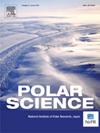区域气候模式对北极近地表风速变化的预估
IF 2
4区 地球科学
Q3 ECOLOGY
引用次数: 0
摘要
在代表性浓度路径(RCP) 4.5和8.5情景下,采用区域气候模式(RCM)模拟北极近地面风速的季节变化。此外,利用RCM RCA-GUESS (RCA4 with interactive vegetation dynamics)研究了不同RCP情景下生物地球物理反馈对近地面风速的调节作用。我们的研究结果表明,海冰减少引起的海洋表面粗糙度的降低导致北冰洋近地面风速的预估增加,其中秋季和冬季的影响最为明显。总的来说,RCM对近地面风速的预估变化与强迫gcm的变化是一致的,尽管RCM模拟的变化幅度比gcm大。陆地植被的扩张增加了地表粗糙度,并通过改变静稳定性和海陆温对比改变大气环流,从而导致近地面风速的变化。具体来说,大陆地区的风速降低,但北冰洋部分地区的风速增加。本研究强调植被的相互作用动态对地表特性和近地表风速的变化有显著影响。这些过程应纳入地球系统模式,以提高未来气候预测的准确性。本文章由计算机程序翻译,如有差异,请以英文原文为准。
Projected changes in near-surface wind speed in the Arctic by a regional climate model
This study investigates seasonal changes in near-surface wind speeds in the Arctic using the regional climate model (RCM) simulations with RCA4 driven by four global climate models (GCMs) CMIP5 under Representative Concentration Pathways (RCP) 4.5 and 8.5 scenarios. In addition, the RCM RCA-GUESS (RCA4 with interactive vegetation dynamics) is used to investigate the role of biogeophysical feedbacks in modulating near-surface wind speeds under different RCP scenarios. Our results show that the reduction in ocean surface roughness induced by sea-ice reduction leads to a projected increase in near-surface wind speeds over the Arctic Ocean, with the most pronounced effects occurring in autumn and winter. Overall, the projected changes in near-surface wind speeds from the RCM are consistent with the changes from the forcing GCMs though the RCM simulations show larger amplitude changes compared to the GCMs. The expansion of vegetation on land increases surface roughness and alters atmospheric circulation by modifying static stability and the land-sea temperature contrast, leading to changes in near-surface wind speeds. Specifically, wind speeds decrease over continental regions but increase over parts of the Arctic Ocean. This study emphasizes that interactive vegetation dynamics significantly influence changes in land surface properties and near-surface wind speeds. These processes should be incorporated into Earth system models to enhance the accuracy of future climate projections.
求助全文
通过发布文献求助,成功后即可免费获取论文全文。
去求助
来源期刊

Polar Science
ECOLOGY-GEOSCIENCES, MULTIDISCIPLINARY
CiteScore
3.90
自引率
5.60%
发文量
46
期刊介绍:
Polar Science is an international, peer-reviewed quarterly journal. It is dedicated to publishing original research articles for sciences relating to the polar regions of the Earth and other planets. Polar Science aims to cover 15 disciplines which are listed below; they cover most aspects of physical sciences, geosciences and life sciences, together with engineering and social sciences. Articles should attract the interest of broad polar science communities, and not be limited to the interests of those who work under specific research subjects. Polar Science also has an Open Archive whereby published articles are made freely available from ScienceDirect after an embargo period of 24 months from the date of publication.
- Space and upper atmosphere physics
- Atmospheric science/climatology
- Glaciology
- Oceanography/sea ice studies
- Geology/petrology
- Solid earth geophysics/seismology
- Marine Earth science
- Geomorphology/Cenozoic-Quaternary geology
- Meteoritics
- Terrestrial biology
- Marine biology
- Animal ecology
- Environment
- Polar Engineering
- Humanities and social sciences.
 求助内容:
求助内容: 应助结果提醒方式:
应助结果提醒方式:


